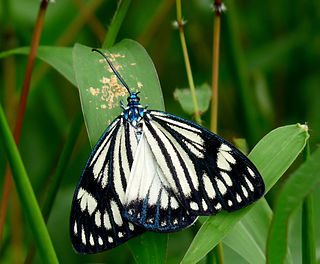
Lepidoptera is an order of insects that includes butterflies and moths. About 180,000 species of the Lepidoptera are described, in 126 families and 46 superfamilies, 10 per cent of the total described species of living organisms. It is one of the most widespread and widely recognizable insect orders in the world. The Lepidoptera show many variations of the basic body structure that have evolved to gain advantages in lifestyle and distribution. Recent estimates suggest the order may have more species than earlier thought, and is among the four most speciose orders, along with the Hymenoptera, Diptera, and Coleoptera.

The Zygaenidae moths are a family of Lepidoptera. The majority of zygaenids are tropical, but they are nevertheless quite well represented in temperate regions. Some of the 1000 or so species are commonly known as burnet or forester moths, often qualified by the number of spots, although other families also have 'foresters'. They are also sometimes called smoky moths.

The Pyraloidea are a moth superfamily containing about 16,000 described species worldwide, and probably at least as many more remain to be described. They are generally fairly small moths, and as such, they have been traditionally associated with the paraphyletic Microlepidoptera.

The de Havilland DH.60 Moth is a 1920s British two-seat touring and training aircraft that was developed into a series of aircraft by the de Havilland Aircraft Company.

Schinia, commonly called flower moths, is a large genus of moths belonging to the family Noctuidae. The genus has a Holarctic distribution with the vast majority of species being found in North America, many with a very restricted range and larval food plant.

The Erebidae are a family of moths in the superfamily Noctuoidea. The family is among the largest families of moths by species count and contains a wide variety of well-known macromoth groups. The family includes the underwings (Catocala); litter moths (Herminiinae); tiger, lichen, and wasp moths (Arctiinae); tussock moths (Lymantriinae), including the arctic woolly bear moth ; piercing moths ; micronoctuoid moths (Micronoctuini); snout moths (Hypeninae); and zales, though many of these common names can also refer to moths outside the Erebidae. Some of the erebid moths are called owlets.

Coptodisca is genus of moths of the family Heliozelidae. It was described by Walsingham in 1895.
Coptodisca diospyriella is a moth of the family Heliozelidae. It was described by Vactor Tousey Chambers in 1874. It is found in North America, including Florida, Kentucky and Ohio.
Coptodisca ella is a moth of the family Heliozelidae. It was described by Vactor Tousey Chambers in 1871. It is found in North America, including Tennessee.
Coptodisca juglandella is a moth of the family Heliozelidae. It was described by Vactor Tousey Chambers in 1874. It is found in North America, including California, Ohio and Illinois.
Coptodisca kalmiella is a moth of the family Heliozelidae. It was described by Dietz in 1921. It is found in North America, including New Jersey.

Coptodisca lucifluella is a moth of the family Heliozelidae. It was described by James Brackenridge Clemens in 1860. It is found in North America, including Kentucky and Ohio.
Coptodisca magnella is a moth of the family Heliozelidae. It was described by Annette Frances Braun in 1916. It is found in North America, including Kentucky, Mississippi and Ohio.
Coptodisca matheri is a moth of the family Heliozelidae. It was described by J. Donald Lafontaine in 1974. It is found in Mississippi.
Coptodisca negligens is a moth of the Lepidopteria family. It was described by Annette Frances Braun in 1920. It is found in North America, including Ohio.
Coptodisca ostryaefoliella is a moth of the family Heliozelidae. It was described by James Brackenridge Clemens in 1861. It is found in North America, including Ohio.
Coptodisca powellella is a moth of the family Heliozelidae. It was described by Opler in 1971. It is found in California.
Coptodisca quercicolella is a moth of the family Heliozelidae. It was described by Annette Frances Braun in 1927. It is found in North America including California and Colorado.
Coptodisca rhizophorae is a moth of the family Heliozelidae. It was described by Walsingham in 1897. It is found in the West Indies.
Coptodisca ribesella is a moth of the family Heliozelidae. It was described by Annette Frances Braun in 1925. It is found in the US state of California.






